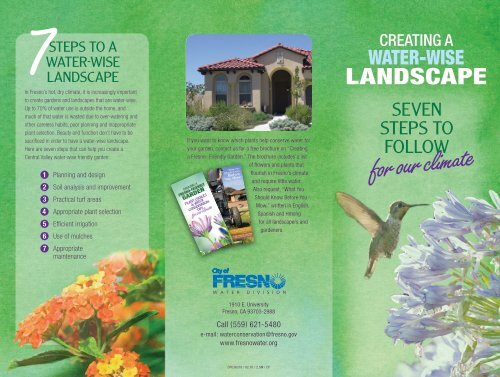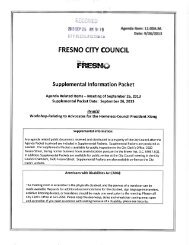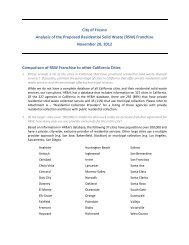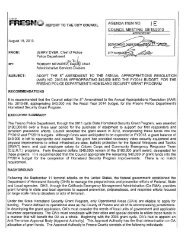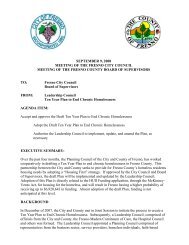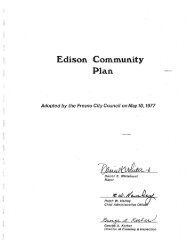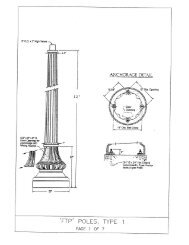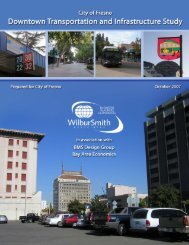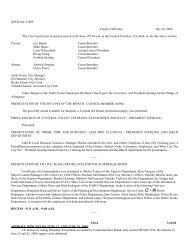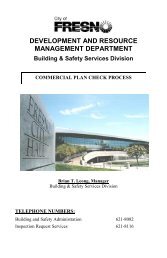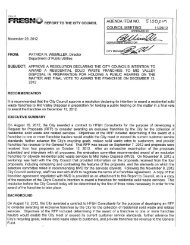Water-Wise Landscape Brochure
Water-Wise Landscape Brochure
Water-Wise Landscape Brochure
Create successful ePaper yourself
Turn your PDF publications into a flip-book with our unique Google optimized e-Paper software.
7StEpS tO a<br />
WatEr-WiSE<br />
LaNdScapE<br />
In Fresno’s hot, dry climate, it is increasingly important<br />
to create gardens and landscapes that are water-wise.<br />
Up to 70% of water use is outside the home, and<br />
much of that water is wasted due to over-watering and<br />
other careless habits, poor planning and inappropriate<br />
plant selection. Beauty and function don’t have to be<br />
sacrificed in order to have a water-wise landscape.<br />
Here are seven steps that can help you create a<br />
Central Valley water-wise friendly garden:<br />
•1 Planning and design<br />
•2 Soil analysis and improvement<br />
•3 Practical turf areas<br />
•4 Appropriate plant selection<br />
•5 Efficient irrigation<br />
•6 Use of mulches<br />
•7 Appropriate<br />
maintenance<br />
If you want to know which plants help conserve water for<br />
your garden, contact us for a free brochure on “Creating<br />
a Fresno- Friendly Garden.” The brochure includes a list<br />
of flowers and plants that<br />
flourish in Fresno’s climate<br />
and require little water.<br />
Also request, “What You<br />
Should Know Before You<br />
Mow,” written in English,<br />
Spanish and Hmong<br />
for all landscapers and<br />
gardeners.<br />
1910 E. University<br />
Fresno, CA 93703-2988<br />
Call (559) 621-5480<br />
e-mail: waterconservation@fresno.gov<br />
www.fresnowater.org<br />
DPU36378 / 02.10 / 2.5M / CP<br />
CREATING A<br />
WATER-WISE<br />
LANDSCAPE<br />
SEVEN<br />
StEpS tO<br />
FOLLOW<br />
for our climate
Step 1: Planning and design<br />
You may get a better perspective on your garden if you take a few<br />
minutes to draw it on paper. Measure the yard and transfer the<br />
measurements to graph paper, plotting the permanent features,<br />
i.e., hardscape, sidewalk, driveway, pool, trees, and the plants that<br />
you want to keep. Then try to envision how you want to use your<br />
yard and what you want it to look like. Advice from a professional<br />
landscape architect, designer or nursery can come in handy, as<br />
these folks are familiar with local plant materials, soil conditions<br />
and general design principles.<br />
Step 2: Soil analysis and improvement<br />
Soils in the Central Valley range from sand to clay, so it’s<br />
important to know what kind of soil your plants will be growing<br />
in. Soil analysis is critical to optimize the soil’s water-holding<br />
capacity, yet provide good drainage. Organic amendments like<br />
compost benefit most soils.<br />
Step 3: Practical turf areas:<br />
Shrink the Lawn!<br />
Across the West, lawns are the number one consumer of<br />
residential water outdoors. Reducing their size, restricting them<br />
to spaces where you actually need them (like kids’ or pets’ play<br />
areas), or eliminating non-recreational lawn altogether are the<br />
most effective ways to reduce your own outdoor water use.<br />
Step 4: Appropriate plant selection<br />
Choose natives and/or plants from climates that are similar to<br />
the West’s dry areas. Shrubs, trees, perennials, and grasses<br />
from other dry regions like Australia, the Mediterranean, and<br />
South Africa are good choices. Group plants with similar water<br />
needs into hydrozones: regular<br />
(basil, strawberries), moderate<br />
(grapevines, rosemary), and low<br />
(native grasses). Use separate<br />
valves to give each hydrozone<br />
the water it needs – and<br />
no more.<br />
Schedule<br />
irrigation wisely.<br />
<strong>Water</strong> early in the morning (before 6aM)<br />
when the air is calm and temperatures are cool. Go to<br />
www.fresnowater.org for the current outdoor watering schedule.<br />
Step 5: Efficient irrigation<br />
With common watering practices, a large portion of the water<br />
applied to lawns and garden beds is not absorbed by the<br />
plants. It is lost through evaporation or runoff, or is pushed<br />
beyond the root zone because it is applied too quickly or in<br />
excess of the plants’ needs. The goal of efficient irrigation is<br />
to reduce these losses by applying only as much water as is<br />
needed to keep your plants healthy.<br />
When your landscape is fairly dry to a depth of 1-2”, water it well,<br />
soaking the soil to a depth of 6-8”. This will promote deep root<br />
growth, making your lawn and other plants more drought tolerant.<br />
Step 6: Mulch and Compost<br />
Mulch saves water by cooling<br />
the soil, reducing evaporation,<br />
and suppressing weed growth<br />
which robs desired plants of<br />
needed water. Mulch can be<br />
inorganic (pebbles, weed block,<br />
plastic) or organic (leaves, wood chips). Organic mulches<br />
add nutrients to the soil and improve drainage. Since organic<br />
mulch breaks down, it will periodically need to be reapplied<br />
to a depth of 2-4” to maximize the benefits. Compost is a soil<br />
amendment that can be incorporated into the soil to improve<br />
drainage in clay/compacted soils or increase waterholding<br />
capacity in sandy soils.<br />
Last<br />
BUT FAR FROM LEAST …<br />
Step 7: Appropriate maintenance<br />
Appropriate maintenance is critical once the other water-saving<br />
steps are in place. Reduce the amount of fertilizer applied,<br />
particularly during dry periods, and only use organic or slowrelease<br />
fertilizers. Minimize summer pruning that encourages<br />
new, succulent growth, which has a high demand for water.<br />
Grasscycling, the practice of leaving grass clippings on the turf<br />
area instead of bagging them, adds moisture and nutrients back<br />
to the turf and conserves moisture by acting as a mulch at the<br />
base of the grass blades.


